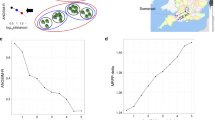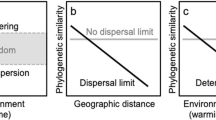Abstract
Although molecular data have revealed the vast scope of microbial diversity1, two fundamental questions remain unanswered even for well-defined natural microbial communities: how many bacterial types co-exist, and are such types naturally organized into phylogenetically discrete units of potential ecological significance? It has been argued that without such information, the environmental function, population biology and biogeography of microorganisms cannot be rigorously explored2. Here we address these questions by comprehensive sampling of two large 16S ribosomal RNA clone libraries from a coastal bacterioplankton community. We show that compensation for artefacts generated by common library construction techniques reveals fine-scale patterns of community composition. At least 516 ribotypes (unique rRNA sequences) were detected in the sample and, by statistical extrapolation, at least 1,633 co-existing ribotypes in the sampled population. More than 50% of the ribotypes fall into discrete clusters containing less than 1% sequence divergence. This pattern cannot be accounted for by interoperon variation, indicating a large predominance of closely related taxa in this community. We propose that such microdiverse clusters arise by selective sweeps and persist because competitive mechanisms are too weak to purge diversity from within them.
This is a preview of subscription content, access via your institution
Access options
Subscribe to this journal
Receive 51 print issues and online access
$199.00 per year
only $3.90 per issue
Buy this article
- Purchase on Springer Link
- Instant access to full article PDF
Prices may be subject to local taxes which are calculated during checkout


Similar content being viewed by others
References
Rappé, M. S. & Giovannoni, S. J. The uncultured microbial majority. Annu. Rev. Microbiol. 57, 369–394 (2003)
Curtis, T. P., Sloan, W. T. & Scannell, J. W. Estimating prokaryotic diversity and its limits. Proc. Natl Acad. Sci. USA 99, 10494–10499 (2002)
Rosselló-Mora, R. & Amann, R. The species concept for prokaryotes. FEMS Microbiol. Rev. 25, 39–67 (2001)
Cohan, F. M. What are bacterial species. Annu. Rev. Microbiol. 56, 457–487 (2002)
Palys, T., Nakamura, L. K. & Cohan, F. M. Discovery and classification of ecological diversity in the bacterial world: the role of DNA sequence data. Int. J. Syst. Bacteriol. 47, 1145–1156 (1997)
Venter, C. J. et al. Environmental genome shotgun sequencing of the Sargasso Sea. Science 304, 66–74 (2004)
Hughes, J. B., Hellmann, J. J., Ricketts, T. H. & Bohannan, B. J. M. Counting the uncountable: statistical approaches to estimating microbial diversity. Appl. Environ. Microbiol. 67, 4399–4406 (2001)
Martin, A. P. Phylogenetic approaches for describing and comparing the diversity of microbial communities. Appl. Environ. Microbiol. 68, 3673–3682 (2002)
Acinas, S. G., Marcelino, L. A., Klepac-Ceraj, V. & Polz, M. F. Divergence and redundancy of 16S rRNA sequences in genomes with multiple rrn operons. J. Bacteriol. 186, 2629–2635 (2004)
Klappenbach, J. A., Dunbar, J. M. & Schmidt, T. M. rRNA operon copy number reflects ecological strategies of bacteria. Appl. Environ. Microbiol. 66, 1328–1333 (2000)
Hacker, J. & Carniel, E. Ecological fitness, genomic islands and bacterial pathogenicity—a Darwinian view of the evolution of microbes. EMBO Rep. 2, 376–381 (2001)
Lan, R. T. & Reeves, P. R. When does a clone deserve a name? A perspective on bacterial species based on population genetics. Trends Microbiol. 9, 419–424 (2001)
Welch, R. A. et al. Extensive mosaic structure revealed by the complete genome sequence of uropathogenic Escherichia coli. Proc. Natl Acad. Sci. USA 99, 17020–17024 (2002)
Daubin, V., Moran, N. A. & Ochman, H. Phylogenetics and the cohesion of bacterial genomes. Science 301, 829–832 (2003)
Rocap, G. et al. Genome divergence in two Prochlorococcus ecotypes reflects oceanic niche differentiation. Nature 424, 1042–1047 (2003)
Schleper, C. A. et al. Genomic analysis reveals chromosomal variation in natural populations of the uncultured psychrophilic archaeon Crenarchaeum symbiosum. J. Bacteriol. 180, 5003–5009 (1998)
Béja, O. et al. Comparative genomic analysis of archaeal genotypic variants in a single population and in two different oceanic provinces. Appl. Environ. Microbiol. 68, 335–345 (2002)
Thingstad, T. F. Elements of a theory for the mechanisms controlling abundance, diversity, and biogeochemical role of lytic bacterial viruses in aquatic systems. Limnol. Oceanogr. 45, 1320–1328 (2000)
Lan, R. T. & Reeves, P. R. Intraspecies variation in bacterial genomes: the need for a species genome concept. Trends Microbiol. 8, 396–401 (2000)
Klepac-Ceraj, V. et al. High overall diversity and dominance of microdiverse relationships in salt marsh sulfate-reducing bacteria. Environ. Microbiol. doi: 10.1111/j.1462–2920.2004.00600.x (2004)
Connon, S. A. & Giovannoni, S. J. High-throughput method for culturing microorganisms in very low nutrient media yield diverse new marine isolates. Appl. Environ. Microbiol. 768, 3878–3885 (2002)
Vergin, K. L. et al. Screening of a fosmid library of marine environmental genomic DNA fragments reveals four clones related to members of the order Planctomycetales. Appl. Environ. Microbiol. 64, 3075–3078 (1998)
Thompson, J. R., Marcelino, L. A. & Polz, M. F. Heteroduplexes in mixed-template amplifications: formation, consequences and elimination by ’reconditioning PCR’. Nucleic Acids Res. 30, 2083–2088 (2002)
Cole, J. R. et al. The Ribosomal Database Project (RDP-II): previewing a new autoaligner that allows regular updates and the new prokaryotic taxonomy. Nucleic Acids Res. 31, 442–443 (2003)
Hugenholtz, P. & Huber, T. Chimeric 16S rDNA sequences of diverse origin are accumulating in the public databases. Int. J. Syst. Evol. Microbiol. 53, 289–293 (2003)
Field, K. G. et al. Diversity and depth-specific distribution of SAR11 cluster rRNA genes from marine planktonic bacteria. Appl. Environ. Microbiol. 63, 63–70 (1997)
Pybus, O. G. & Rambaut, A. GENIE: Estimating demographic history from molecular phylogenies. Bioinformatics 18, 1404–1405 (2003)
Ludwig, W. et al. ARB: a software environment for sequence data. Nucleic Acids Res. 32, 1363–1371 (2004)
Swofford, D. L. PAUP*. Phylogenetic Analysis Using Parsimony (*And Other Methods) Version 4 (Sinauer Associates, Sunderland, Massachusetts, 2002)
Acknowledgements
We thank S. Bertilsson (Uppsala University) for sample collection, D. Veneziano (MIT) for discussions on statistical extrapolation of sequence diversity, P. Chisholm (MIT) for numerous suggestions, and researchers and staff of the PIE-LTER (Plum Island Ecosystem-Long Term Ecological Research) for logistical support. This work was supported by grants from the National Science Foundation, the Department of Energy Genomes to Life program and a postdoctoral fellowship from the Spanish Ministry of Education to S.G.A.
Author information
Authors and Affiliations
Corresponding author
Ethics declarations
Competing interests
The authors declare that they have no competing financial interests.
Supplementary information
Supplementary Figure 1
Phylogenetic distance (neighbour-joining) tree of all unique 16S rRNA gene sequences (ribotypes) retrieved from the Plum Island bacterioplankton sample and representative reference sequences. (PDF 33 kb)
Supplementary Figure Legend
Key to cluster numbers from Figure 2a in main paper. (RTF 4 kb)
Rights and permissions
About this article
Cite this article
Acinas, S., Klepac-Ceraj, V., Hunt, D. et al. Fine-scale phylogenetic architecture of a complex bacterial community. Nature 430, 551–554 (2004). https://doi.org/10.1038/nature02649
Received:
Accepted:
Issue Date:
DOI: https://doi.org/10.1038/nature02649
This article is cited by
-
Horizontal gene transfer is predicted to overcome the diversity limit of competing microbial species
Nature Communications (2024)
-
Multicenter evaluation of gut microbiome profiling by next-generation sequencing reveals major biases in partial-length metabarcoding approach
Scientific Reports (2023)
-
Global scale phylogeography of functional traits and microdiversity in Prochlorococcus
The ISME Journal (2023)
-
A computationally efficient approach to estimating species richness and rarefaction curve
Computational Statistics (2022)
-
Bacteria in (vermi)composted organic wastes mostly survive when applied to an arable soil cultivated with wheat (Triticum sp. L.)
Environmental Monitoring and Assessment (2022)
Comments
By submitting a comment you agree to abide by our Terms and Community Guidelines. If you find something abusive or that does not comply with our terms or guidelines please flag it as inappropriate.



